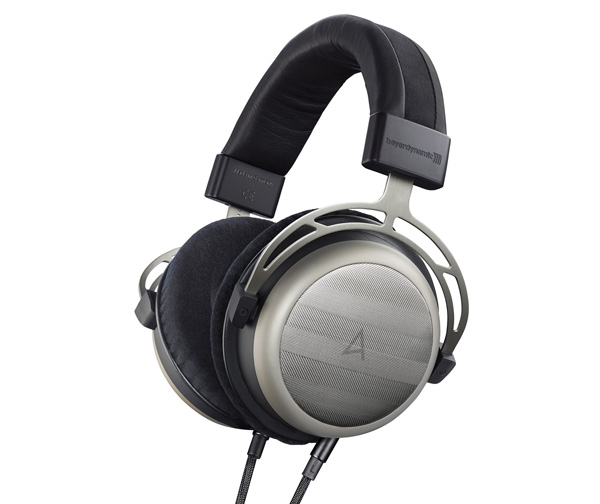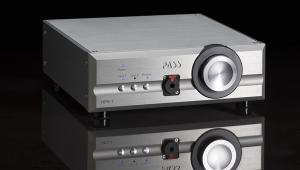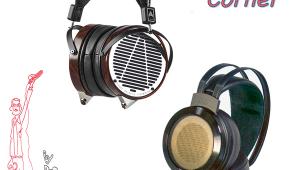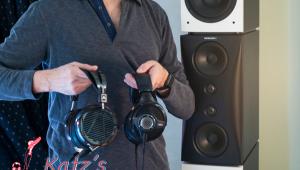| Columns Retired Columns & Blogs |
Katz's Corner Episode 9: Astell & Kearn AK T1p Headphones and AK380 Music Player

This story originally appeared at InnerFidelity.com
A Serious Listen: Astell & Kearn: AK T1p headphones
These Astel & Kern AK T1p ($1199) cans are among the most beautiful, striking designs around; an artsy, pristine piece. Beautiful brushed metal, luxurious comfortable pads, lightweight, produced by a partnership between A&K and beyerdynamic. This is a worthy sight on anyone's head. Smaller in diameter than my reference Audeze LCD-X, but still circumaural. Each A&K phone is hand-made, individually serialized: I'm reviewing #335. It comes with balanced and unbalanced cables, but I auditioned unbalanced.

I'm not a shy guy. If I don't like a headphone, I'll pull it off my ears within five minutes! So far, I've had the Astell & Kearn AK T1p on for over 40 minutes and I keep wanting to check them out—so there must be something about them that's keeping me listening. They call it a "semi-open" headphone...I don't hear any closed-in artifacts, they sound very transparent. Initially I find their sound attractive, warm, natural. But still there's something that's bothering me about these cans. I begin to feel they're a bit "polite", they never seem to kick with any recording. What's that about?
To get to the bottom of the matter I played one of my reference recordings, my own recording of Rebekka Pidgeon singing "Spanish Harlem" from her album "The Raven" on Chesky Records, the 176.4 kHz HD tracks "Bob Katz remastering, special edition." Now the issue becomes clear: There is a presence boost, centered at approximately 5 kHz. With the A&Ks, Rebekka's warm voice has become strongly sibilant. I know what she sounds like in person, plus, having heard this recording in many places, I know it is warmer and not so strongly present in the 5kHz range.
My diagnosis: the reason this peak comes on you slowly is that it is an extremely wide (low-Q) resonance. This is clearly a design decision on Beyer and A&K's part, to produce an immediately-perceived transparency that can be attractive to a lot of listeners. In contrast, a high-Q resonance (a sharp peak) can sound fatiguing, not the case with the A&K's, or they would not have passed my five minute test. In fact, they stayed on my head for a few hours! Too many headphones have instantly-identifiable sharp peaks in their responses, like the Sennheeiser HD 800's, but this is fortunately not the case with the A&Ks. These A&K cans feature second generation "Tesla" technology, which they claim eliminates even the last traces of resonance in the high frequency range.
Next, I check out some classical music: Also pre-installed on this A&K demo player, a high-res piece from Chesky, "Waltz of the Flowers", 24/96 from HD tracks, Bruckner Orchester Linz. This Tchaikovsky recording reinforced my impression...that these are destined to be classical music lovers' headphones. While I found the presence boost initially off-putting, it was easy to get used to, just a bit too "hi-fi" for this critical audiophile. But I'm sure these phones will be very attractive to any music listener who desires a lightweight headset that feels and sounds great. If only we could turn down that 5kHz range and fill in the lower midrange and bass just a hair, these A&K cans would be an amazing piece.
When I switched to my Audeze LCD-X cans, the Bruckner orchestra immediately sounded more attractive, with more warmth and body, string basses regained their drive. Then I switched to my custom-built M3 amplifier and the DAC from a Slimbox Transporter so I could play a wide variety of familiar sources from my collection in JRiver, alternating between the LCD-X cans and the A&Ks. I did not use any compensating EQ for the Audeze, so readers will get the raw dope. Since I have Rebekka's original master on my server, I replayed the song. With the LCD-X, Rebekka's romance was back, her voice instantly recovered its warmth and fullness. A bit too much, in fact, which was one of my motivations for equalizing the LCD-X in the first place. Still, her voice sounded more correct on the Audeze.
I do think this presence boost is the origin for my impression that the A&K sounds too polite. This is not a rock and roller's can... Steely Danners and Patricia Barberers will like the A&K more than Led Zeppelliners. Classical and jazz lovers could easily fall in love with this can, especially with its lightness and beauty.
Nevertheless, I strongly believe there does not have to be a "genre headphone": there is no such thing as a "classical music speaker" or "classical music headphone"—or a "hip hop headphone", though Apple and Beats would like you to think so. When a transducer is absolutely accurate, every style of music should sound right. But life is a compromise, and especially considering their great comfort, clearly the A&K's will satisfy a large group of listeners who like a relaxed, transparent sound and for whom power and punch are not high priorities. I know a lot of women (and men) who will fall in love with this combination of styling, light weight, and transparent sound. I definitely would not kick these beautifully-made, lightweight A&K's out of bed.
With the A&K, there's barely a wink of robust body and deep beauty. Though the A&K definitely have some bass, it's, well...polite. So personally, I keep returning to my Audeze—for as long as I can tolerate their weight. Still, you have to pay more than a $500 premium for the Audeze! Are there any more accurate headphones than the A&K in the under $1200 category? Do we really have to invest close to $2000 to satisfy our appetite for musical body and soul? We shall see, in future Katz's Corner investigations.
 A Quick Look: Astell & Kearn AK380 Music Player
A Quick Look: Astell & Kearn AK380 Music Player
I'm privileged to be able to audition phones today using the premium DAC and headphone amp in the portable AK380 music player, which retails for a premium price: $3499. This player has a sharp, large LCD screen and is built quite ruggedly. Its custom operating system is easy to learn to use if you're comfortable with LCD touchscreen menus. The sound: scary good! In fact I prefer the sound of this battery-operated player more than JRiver feeding my Slim Devices DAC into my M3 amp! Amazingly, the portable player sounds warmer and more inviting than all my wall-powered stuff. I really hope it's just my DAC. I can use a new DAC, but not a new amp! I've been planning on building an ESS DAC like what's in the A&K for quite a while and this is my motivation.
We could characterize the A&K phones as being in the sonic minor leagues, but the A&K music player is definitely in the majors. The player is capable of feeding a good pair of cans to the limit of their ability—an amazing achievement for a portable device.
However...
The player crashed on me three times in two hours during this review period. I had to do a soft reset, achieved by pressing and holding the up arrow button on the side with the power button on the top. This is not the sort of thing you'd expect from a $3500 device.
After resetting the player and going through the two minute reboot, I played a number of other sources through my reference Audeze cans. I heard great micro- and macro-dynamics, perfect separation and soundstage. It's very satisfying...the A&K amp is up to anything. I do like the sound of this box—if we can keep it stable. It's now the best sounding DAC in this room...what a revelation.
I tried to dip the 5kHz presence boost from the A&K headphones using the equalizer in the player, but I could not get its equalizer to change the sound, although the sliders were moveable, the sound did not change. There is a built-in "Pro EQ preset" which is not user-changeable but it did not appear to change the sound to my ears. In or out it sounded the same to me, at least with this software revision and this player model. What is the meaning of "Pro EQ" anyway? Equalization should be program or transducer-dependent, not a one-size-fits-all solution; that would be like putting salt and pepper on your food before you can taste it! Next I set up a user-adjustable-setting. Inserting the user-setting dropped the sound level perhaps 6 dB but none of its band sliders had any audible effect. Users of earlier models have reported success with the equalization so this must be a bug they did not test for.
I regret to say given this issue and the frequent crashes I cannot recommend this player at this time. If you are interested in this great-sounding player, make certain that A&K has solved the stability and equalization issues. Get one and try it out. I do not know the software release, but no one touched this player before I opened it from the factory-sealed box January 2016.
Editor's Note:
Ha! Welcome to our world, Bob. The amount of buggy and difficult to use enthusiast stuff is disheartening at times. In fact, when I reviewed Astel & Kern's earlier AK120 I found myself ready to throw it into the campfire by the end of the trip.
But!
I've also reviewed the previous flagship AK240 and found the sound quality solid...but the user interface terrific! I'm shocked you had buggy issues. So much so, that I just rang up the folks at Astel & Kern and am having a unit shipped up ASAP.
I'm also tantalized by your impressions of it's sound. I thought the AK240 quite good, but not at the level you're describing. Sounds like I'm in for some interesting listening. I'll report back.
Thanks for your words, Bob!
- Log in or register to post comments




































